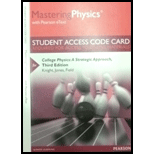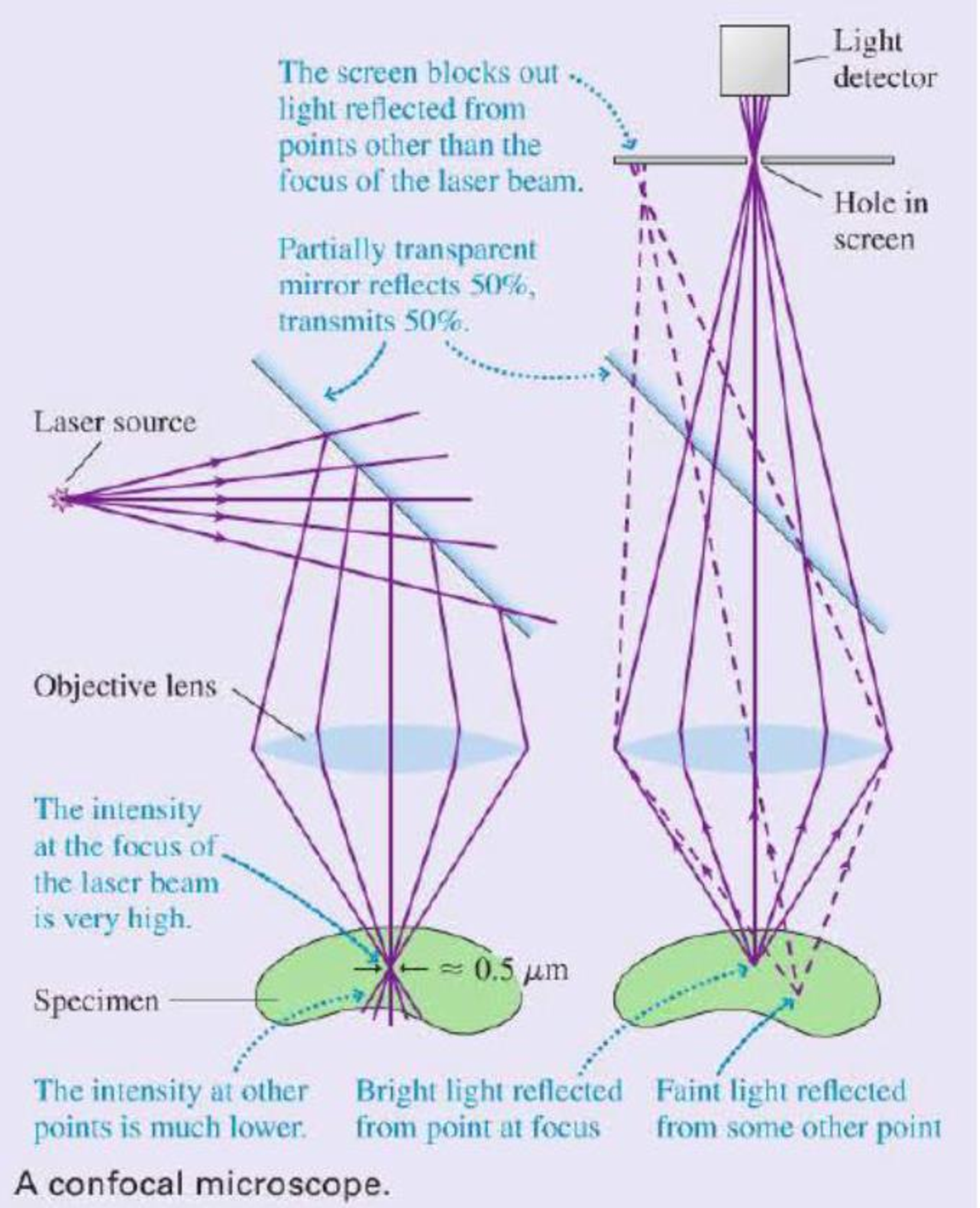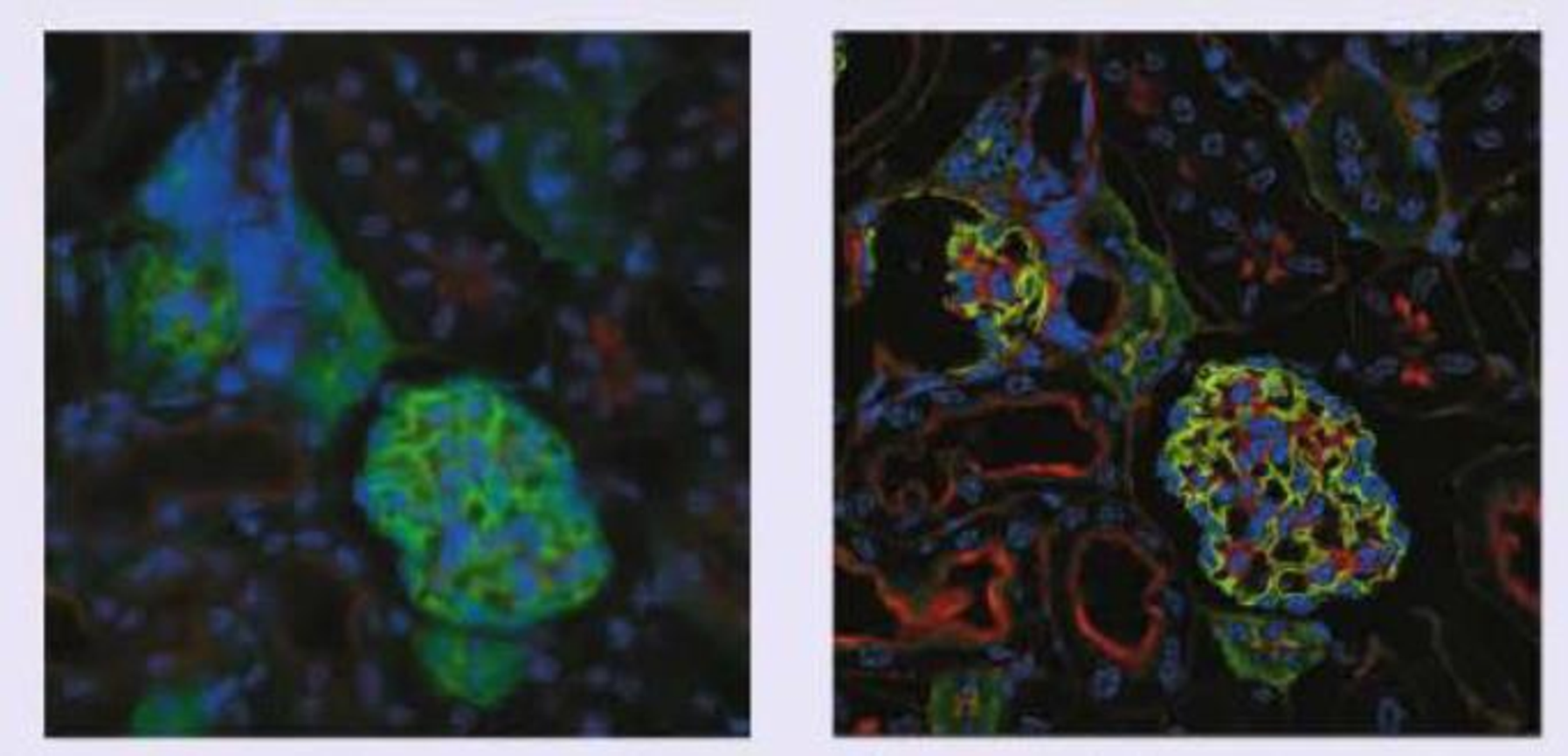
Concept explainers
Scanning Confocal Microscopy
Although modern microscopes are marvels of optical engineering, their basic design is not too different from the 1665 compound microscope of Robert Hooke. Recently, advances in optics, lasers, and computer technology have made practical a new kind of optical microscope, the scanning confocal microscope. This microscope is capable of taking images of breathtaking clarity.
The figure shows the microscope’s basic principle of operation. The left part of the figure shows how the translucent specimen is illuminated by light from a laser. The laser beam is converted to a diverging bundle of rays by suitable optics, reflected off a mirror, then directed through a microscope objective lens to a focus within the sample. The microscope objective focuses the laser beam to a very small (≈ 0.5 μm) spot. Note that light from the laser passes through other regions of the specimen but, because the rays are not focused in those regions, they are not as intensely illuminated as is the point at the focus. This is the first important aspect of the design: Very intensely illuminate one very small volume of the sample while leaving other regions only weakly illuminated.
As shown in the right half of the figure, light is reflected from all illuminated points in the sample and passes back through the objective lens. The mirror that had reflected the laser light downward is actually a partially transparent

mirror that reflects 50% of the light and transmits 50%. Thus half of the light reflected upward from the sample passes through the mirror and is focused on a screen containing a small hole. Because of the hole, only light rays that emanate from the brightly illuminated volume in the sample can completely pass through the hole and reach the light detector behind it. Rays from other points in the sample either miss the hole completely or are out of locus when they reach the screen, so that only a small fraction of them pass through the hole. This second key design aspect limits the detected light to only those rays that are emitted from the point in the sample at which the laser light was originally focused.
So we see that (a) the point in the sample that is at the focus of the objective is much more intensely illuminated than any other point, so it reflects more rays than any other point, and (b) the hole serves to further limit the detected rays to only those that emanate from the focus. Taken together, these design aspects ensure the detected light comes from a very small, very well-defined volume in the sample.
The microscope as shown would only be useful for examining one small point in the sample. To make an actual image, the objective is scanned across the sample while the intensity is recorded by a computer. This procedure builds up an image of the sample one scan line at a time. The final result is a picture of the sample in the very narrow plane in which the laser beam is focused. Different planes within the sample can be imaged by moving the objective up or down before scanning. It is actually possible to make three dimensional images of a specimen in this way.
The improvement in contrast and resolution over conventional microscopy can be striking. The images show a section of a mouse kidney taken using conventional and confocal microscopy. Because light reflected from all parts of the specimen reaches the camera in a conventional microscope, that image appears blurred and has low contrast. The confocal microscope image represents a single plane or slice of the sample, and many details become apparent that are invisible in the conventional image.

A section of fluorescently stained mouse kidney imaged using standard optical microscopy (left) and scanning confocal microscopy (right).
The following questions are related to the passage “Scanning Con focal Microscopy” on the previous page.
1. A laser beam consists of parallel rays of light. To convert this light to the diverging rays required for a scanning confocal microscope requires
- A. A converging lens.
- B. A diverging lens.
- C. Either a converging or a diverging lens.
Want to see the full answer?
Check out a sample textbook solution
Chapter P Solutions
Mastering Physics with Pearson eText -- Standalone Access Card -- for College Physics: A Strategic Approach (3rd Edition)
Additional Science Textbook Solutions
Cosmic Perspective Fundamentals
Microbiology: An Introduction
Campbell Biology in Focus (2nd Edition)
Organic Chemistry (8th Edition)
Human Anatomy & Physiology (2nd Edition)
Human Physiology: An Integrated Approach (8th Edition)
- please help me solve this questions. show all calculations and a good graph too :)arrow_forwardWhat is the force (in N) on the 2.0 μC charge placed at the center of the square shown below? (Express your answer in vector form.) 5.0 με 4.0 με 2.0 με + 1.0 m 1.0 m -40 με 2.0 μCarrow_forwardWhat is the force (in N) on the 5.4 µC charge shown below? (Express your answer in vector form.) −3.1 µC5.4 µC9.2 µC6.4 µCarrow_forward
- An ideal gas in a sealed container starts out at a pressure of 8900 N/m2 and a volume of 5.7 m3. If the gas expands to a volume of 6.3 m3 while the pressure is held constant (still at 8900 N/m2), how much work is done by the gas? Give your answer as the number of Joules.arrow_forwardThe outside temperature is 25 °C. A heat engine operates in the environment (Tc = 25 °C) at 50% efficiency. How hot does it need to get the high temperature up to in Celsius?arrow_forwardGas is compressed in a cylinder creating 31 Joules of work on the gas during the isothermal process. How much heat flows from the gas into the cylinder in Joules?arrow_forward
- The heat engine gives 1100 Joules of energy of high temperature from the burning gasoline by exhausting 750 Joules to low-temperature . What is the efficiency of this heat engine in a percentage?arrow_forwardL₁ D₁ L₂ D2 Aluminum has a resistivity of p = 2.65 × 10 8 2. m. An aluminum wire is L = 2.00 m long and has a circular cross section that is not constant. The diameter of the wire is D₁ = 0.17 mm for a length of L₁ = 0.500 m and a diameter of D2 = 0.24 mm for the rest of the length. a) What is the resistance of this wire? R = Hint A potential difference of AV = 1.40 V is applied across the wire. b) What is the magnitude of the current density in the thin part of the wire? Hint J1 = c) What is the magnitude of the current density in the thick part of the wire? J₂ = d) What is the magnitude of the electric field in the thin part of the wire? E1 = Hint e) What is the magnitude of the electric field in the thick part of the wire? E2 =arrow_forwardplease helparrow_forward
 University Physics Volume 3PhysicsISBN:9781938168185Author:William Moebs, Jeff SannyPublisher:OpenStax
University Physics Volume 3PhysicsISBN:9781938168185Author:William Moebs, Jeff SannyPublisher:OpenStax Physics for Scientists and Engineers: Foundations...PhysicsISBN:9781133939146Author:Katz, Debora M.Publisher:Cengage Learning
Physics for Scientists and Engineers: Foundations...PhysicsISBN:9781133939146Author:Katz, Debora M.Publisher:Cengage Learning
 Principles of Physics: A Calculus-Based TextPhysicsISBN:9781133104261Author:Raymond A. Serway, John W. JewettPublisher:Cengage Learning
Principles of Physics: A Calculus-Based TextPhysicsISBN:9781133104261Author:Raymond A. Serway, John W. JewettPublisher:Cengage Learning Glencoe Physics: Principles and Problems, Student...PhysicsISBN:9780078807213Author:Paul W. ZitzewitzPublisher:Glencoe/McGraw-Hill
Glencoe Physics: Principles and Problems, Student...PhysicsISBN:9780078807213Author:Paul W. ZitzewitzPublisher:Glencoe/McGraw-Hill Physics for Scientists and Engineers with Modern ...PhysicsISBN:9781337553292Author:Raymond A. Serway, John W. JewettPublisher:Cengage Learning
Physics for Scientists and Engineers with Modern ...PhysicsISBN:9781337553292Author:Raymond A. Serway, John W. JewettPublisher:Cengage Learning





